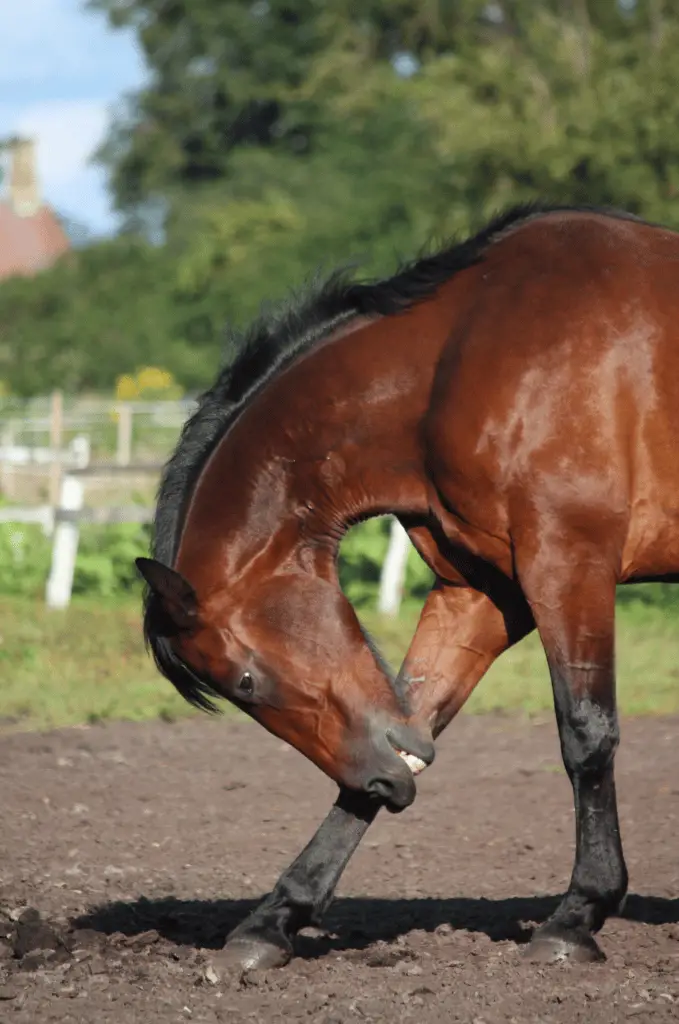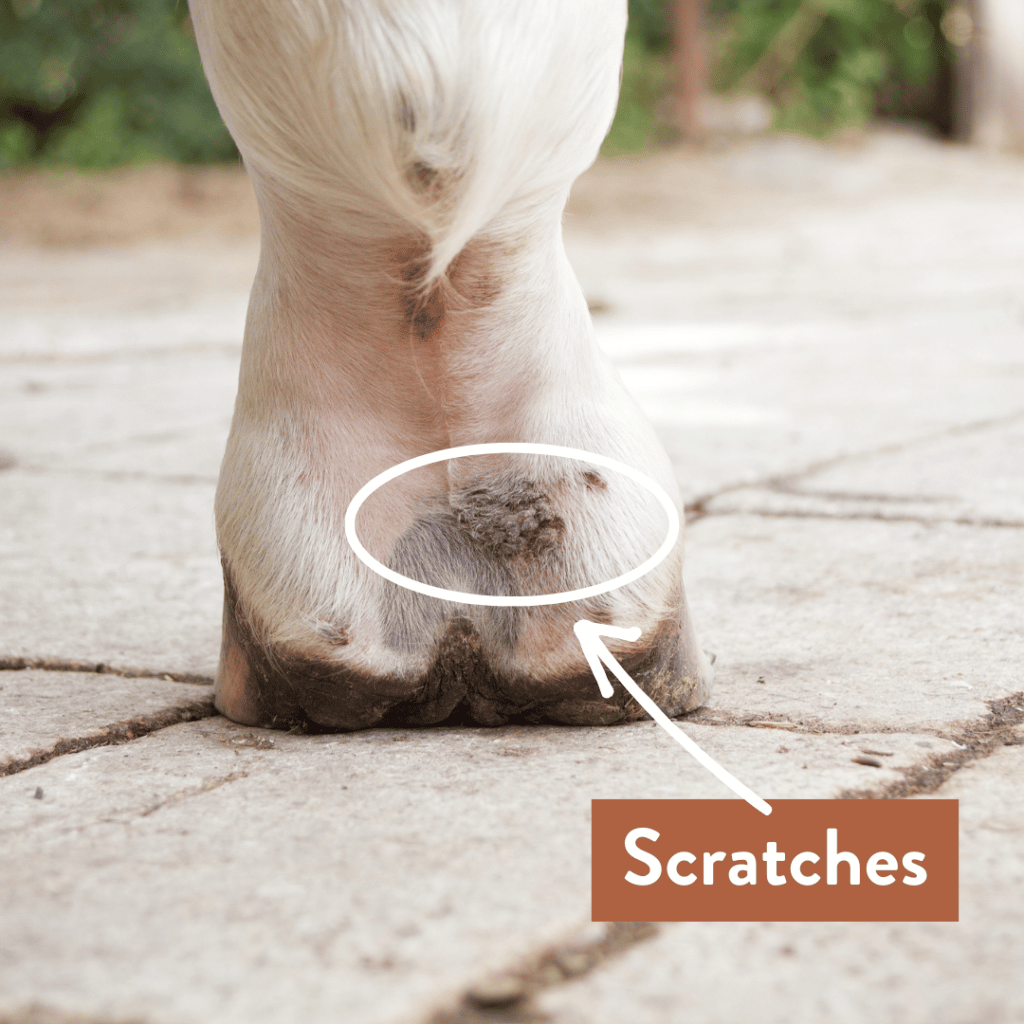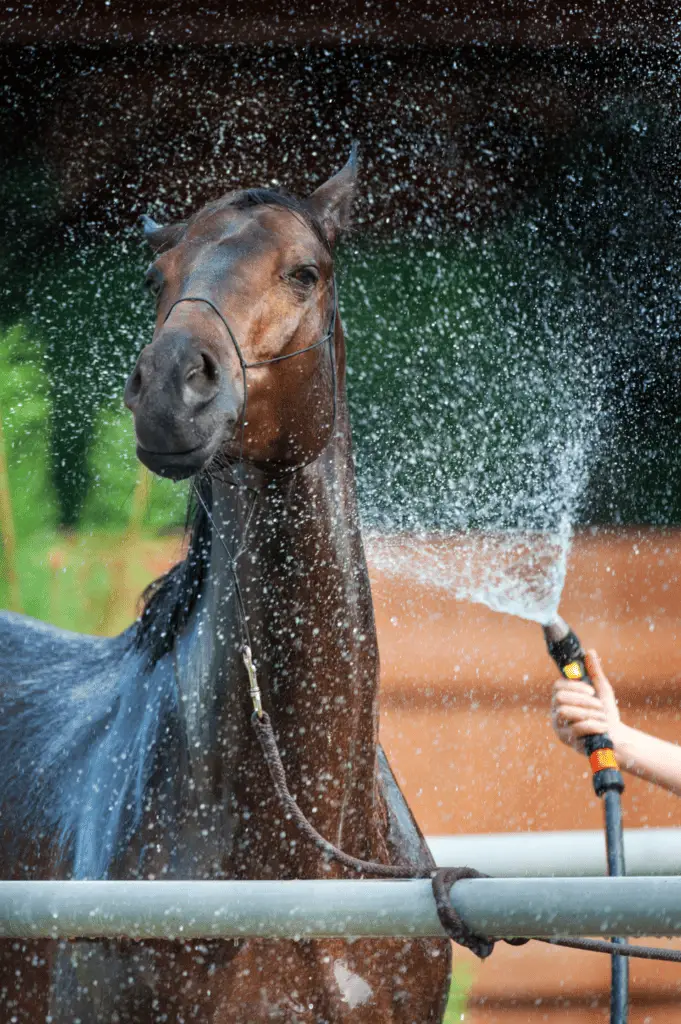There’s nothing worse than saddling up for a nice ride, only to realize your horse seems lame. Upon closer inspection, a swollen fetlock and red scabby pastern greets you! Horse scratches are one of every horse owner’s worst nightmares.
Here’s how to deal with them.
The contents of this article are intended to inform and guide readers, but the final decision on treatment is always the owner’s prerogative. When your horse has a severe infection, it’s always advisable to contact your vet immediately for professional assessment, treatment, and advice.
What Are Equine Scratches?
In humans, a “scratch” is usually a mild scrape of the top layer of skin, but it’s different in horses.
Equine “scratches” is a skin condition that results from exposure to wet conditions that allow various bacteria, fungi, and microorganisms to enter the horse’s dermis and cause inflammation and infection. It’s often called horse scratch because the horse may try to scratch at the area with their teeth.
Horses of any size and breed can be affected by scratches, either on one or more legs, but larger breeds such as draft horses are known to be especially vulnerable to scratches.
Draft breeds and horses with feathers such as Friesians are susceptible to scratches because of the moisture retention that feathers encourage. The skin of the lower legs gets wet and raw, and with the smallest nick, opportunistic bacteria enter the picture.
A Scratch by a Different Name
If you’re still in the dark as to what exactly scratches are, you’ve most likely seen it before—most horse owners have. Scratches have many different names, from mud fever and greasy heel to cracked heels, dew fever, and the medical name: equine pastern dermatitis.
All these names describe the same basic condition where the lower leg, from the coronary band and the heel bulbs to as high as the knee or hock, is affected by swelling, raw and crusty scabs, and inflammation that can bring about lameness.

How Do Scratches Affect Horses?
If your horse has had scratches, you probably know how painful this condition can be. Scratches can cause severe swelling of the fetlock and pastern, even moving as high as the knee or lower leg, which will result in severe lameness.
Secondary infections of the raw pastern dermatitis sites can cause the oozing of exudate and yellow or green pus.
While horses don’t normally die of scratches, the condition can be excruciating, and some horses may even experience colic triggered by pain and dehydration from not being able to graze effectively or travel to their water trough.
What Causes Scratches?
Scratches are a compound problem. It’s never caused by only one factor.
For starters, most of the bacteria that create the inflammation and infection is already naturally found on your horse’s skin and coat. So where do things go wrong?
These natural microorganisms are supposed to be kept on the outside of your horse’s coat, not inside their skin. When the horse’s skin is softened by excessive exposure to water—like when they’ve been in muddy pastures or deep and wet stall bedding—the skin around their pasterns, fetlocks, and lower legs get raw. All it takes is a slight nick or scrape, and your horse can quickly develop equine scratches.

A Closer Look at Scratches and Your Horse’s Health
Of course, it’s slightly more involved than just a bit of water and then a scrape, but that’s essentially what causes scratches to happen. Let’s look at equine pastern dermatitis in more detail.
Scratches Symptoms
The first step in treating scratches is to correctly identify it. Not all swollen legs are indicative of pastern dermatitis. Your horse should present with some of the following symptoms:
- Raw skin on any section of the lower leg
- Sensitivity to touch
- Crusty scabs
- Clear fluid oozing from scabs (exudate)
- Sensitivity to movement (when the scabs pull or there’s swelling)
- Heat in the affected areas
Scratches Formation Requirements
For scratches to form, there has to be excessive exposure to moisture to the affected areas. While the obvious winner in this category is a muddy pasture, even early morning dew or frost can soften the skin and begin the vicious cycle.
Once the skin has been softened, a few scrapes or even an insect bite such as from mites in the feathers of the fetlock can be enough to open a gap for microorganisms to penetrate and then proliferate.
Bacteria such as Dermatophilus congolensis and Staphylococcus aureus are the usual culprits, but even fungal infections can result before the bacteria even get started. Infection of the hair follicles by microscopic organisms can also create an opportunity for bacteria to enter the horse’s system.
With the area already being like a nuclear war zone, fungi can also pop in to add to the mayhem. The likely culprit is a fungal infection of Sporotrichum Schenckii.
Horse Scratch Treatment
Quite simply: don’t scratch.
We are often told (mistakenly) to scratch off the crusts and scabs. While it can be good to gently remove these so any topical medication can penetrate better, this shouldn’t be done by force. Instead, use a cream or antibacterial soap to gently soak the scabs, soften them, and then massage the area to remove any crusts.
Once the scabs are softened and gently removed, dry the area, and apply a topical ointment such as silver sulfadiazine, corona ointment, or zinc-based ointment when treating localized bacterial infections.
Repeated washing and removal of scabs will usually be required for as much as 7-10 days. In extreme cases, a long-acting antibiotic may also be prescribed as well as prednisolone injections to help reduce the inflammation and clear out any deep infections.
Pastern dermatitis can take up to two weeks to treat, and if the horse doesn’t receive the help it needs to heal, the affected legs can become covered in serious scar tissue (granulation) that can even affect the horse’s joint flexibility.

Treating Scratches in Horses: A Step-by-Step Guide
If you find your horse with a serious case of pastern dermatitis or scratches on their legs, it’s time to jump into action immediately. Here’s a step-by-step guide to help you manage and treat their mud fever.
1. Clean Affected Skin Immediately
When you notice scratches or mud fever on your horse’s legs, it’s important to carefully clean the area with water and an antibacterial or antimicrobial shampoo that contains chlorhexidine, accelerated hydrogen peroxide, and povidone iodine.
Lather up the affected skin, wait 10 minutes, and then gently massage the raw skin until the crusts soften and come away from the skin on their own.
2. Dry the Area and Clip
Water is what started the problem, so don’t leave the area wet. Take a towel and gently dry the affected area. If your horse is a draft breed or has long feathers, it’s a good idea to clip the feathers short so the area can dry more efficiently with less moisture retention.
Clipping the area can help reduce external parasites, such as mites, too.
3. Apply Topical Treatment
Once the affected area is clear of scabs and any long hair has been carefully clipped away, you can apply a topical treatment such as a barrier cream or silver sulfadiazine ointment. However, any horse-safe antibacterial cream will work.
If you choose a cream like Vaseline or zinc-based ointment, it’s a good idea to keep the horse out of areas with sand and mud as these treatments don’t dry, which means the ointments may become mixed with dirt, which can rub the sensitive skin.
4. Continue Treatment
The challenge with scratches treatment is that it’s a long-term treatment, which means you will have to repeat steps one to three every day for 7-10 days until the skin has begun to heal and the broken skin no longer makes scabs or oozes exudate.
Your horse will likely become irritated by these daily washing sessions and application of medication, but it’s a necessary evil.
The swelling of the pastern and fetlock should also have completely dissipated before treatment is stopped.
5. Clinical Treatments
If secondary infections have set in, or where perpetuating causative factors like the horse’s overall health are a challenge, it may be necessary to opt for injectable antibiotics and supportive medication like multivitamin boosters and increased dietary supplementation.
Anti-inflammatory injections may also help decrease the swelling in joints that are excessively swollen.
When scratches on horses become an infectious or zoonotic condition, it may be tempting to take an approach with harsh chemicals, but these strip the natural oils from the horse’s skin. Instead, clinical treatments should focus on treating any secondary bacterial infection while still ensuring the horse’s legs are clean and nourished.
Treatment for the horse may require that it’s carefully established whether the horse has allergic contact dermatitis or worm infections like ringworm and pinworm. The cutaneous reaction pattern responds differently, based on the blood vessel wall inflammation and pus-forming skin infection lesions that characterize scratches in horses.

Preventing Scratches in Horses
When you and your horse have built some immunity to the bacteria that so negatively influence the presence of scratches, it is time to evaluate how you can stop scratches even forming in horses.
Prevent scratches on horses by:
- Cleaning and drying the long hair around the fetlock joint
- Clipping any long hair that hangs over the pastern and fetlock joints
- Treating any signs of raw skin or redness to prevent bacterial infections
- Removing horses from pastures that are waterlogged
- Keeping horses out of pastures where there is mud and where the horses are exposed to harsh UV rays that may cause sunburn on pink skin
- Apply a barrier cream preventatively before scratches appear, especially if your horse is prone to developing bacterial infections.
- Consider putting mud fever boots on your horse when you turn them out.

More FAQs About Equine Scratches
What causes horses to get scratches?
Horses become scratchy and irritated when their legs are not dry or they continuously stand in water, wet grass, or damp bedding.
When horses stand in water for most of the day, they may develop circulation problems, swollen extremities (which are painful), and raw and broken skin. These all create a situation that bacteria can use to infiltrate the horse’s skin and form an infected area.
Are horse scratches fungal?
Horse scratches start off as a bacterial infection. However, other causes may also factor in, such as fungal spores, skin mites, and, of course, bacteria.
Are horse scratches painful?
Initially, horse scratches may only cause the horse some discomfort, but once the infection has really taken root, the affected leg will become filled (or swollen), and inflammation will increase—and this is very painful for the horse.
As horse owners, we try our best to keep our horses healthy and in the best possible condition, but scratches can happen to any horse. All that’s required is some rain, a little mud, or wet bedding, and infection is just around the corner.
Prevention is always advised, so when it’s the rainy season, keep your horses out of muddy pastures, wait for the worst dew to dry off to prevent dew poisoning, and keep horses with pink skin stabled during the day (especially late afternoon). Non-pigmented skin can be especially vulnerable to scratches forming.
If you are interested in giving the absolute best care to your horse, why not read my article on equine dermatitis for more information and tips to prevent painful skin conditions.
Like this post? Save it on Pinterest. Follow me on Pinterest.


